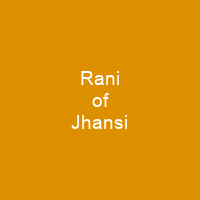Lakshmibai, the Rani of Jhansi (19 November 1828 – 18 June 1858), was an Indian queen of the Maratha princely state. She was one of the leading figures of the Indian Rebellion of 1857. Her role in the massacre of 40 to 60 European officers and their wives, along with their wives and children, is still a subject of debate.
About Rani of Jhansi in brief
 Lakshmibai, the Rani of Jhansi ; 19 November 1828 – 18 June 1858), was an Indian queen of the Maratha princely state. She was one of the leading figures of the Indian Rebellion of 1857 and became a symbol of resistance to the British Raj for Indian nationalists. Her role in the massacre of 40 to 60 European officers and their wives, along with their wives and children, is still a subject of debate. The Rani Mahal has now been converted into a museum. It houses a collection of archaeological remains of the period between the 9th and 12th centuries AD. She gave birth to a boy, later named Damodar Rao, who died four months after birth. The Maharaja adopted a child called Anand Rao, the son of Gangadhar Rao Newalkar, on the day before the Maharaja died. The adoption was in the presence of the British political officer who was given a letter from the Maharajas instructing that the child be treated with respect. In March 1854, Rani Laksh mibai was given an annual pension of Rs. 60,000 and ordered to leave the palace and the fort. According to Vishnu Bhatt Godse, she would exercise at weightlifting, wrestling and steeplechasing before breakfast. Her horses included Sarangi, Pavan and Baadal; according to historians she rode Baadal when escaping from the fort in 1858.
Lakshmibai, the Rani of Jhansi ; 19 November 1828 – 18 June 1858), was an Indian queen of the Maratha princely state. She was one of the leading figures of the Indian Rebellion of 1857 and became a symbol of resistance to the British Raj for Indian nationalists. Her role in the massacre of 40 to 60 European officers and their wives, along with their wives and children, is still a subject of debate. The Rani Mahal has now been converted into a museum. It houses a collection of archaeological remains of the period between the 9th and 12th centuries AD. She gave birth to a boy, later named Damodar Rao, who died four months after birth. The Maharaja adopted a child called Anand Rao, the son of Gangadhar Rao Newalkar, on the day before the Maharaja died. The adoption was in the presence of the British political officer who was given a letter from the Maharajas instructing that the child be treated with respect. In March 1854, Rani Laksh mibai was given an annual pension of Rs. 60,000 and ordered to leave the palace and the fort. According to Vishnu Bhatt Godse, she would exercise at weightlifting, wrestling and steeplechasing before breakfast. Her horses included Sarangi, Pavan and Baadal; according to historians she rode Baadal when escaping from the fort in 1858.
In June 1857, the 12th Infantry seized the Star Fort of JHansi containing the treasure of the Star magazine. An doctor, Thomas Lowe, wrote upon the character of the young Rani: “Jezebel… rani rani of India..Rani Lakshmibi rani.’” She died of a heart attack in a hospital in Delhi in July 1858 and was buried in the city’s Rani Palace. She is buried in a plot of land currently present in Jhinsi district in Uttar Pradesh, India. Her funeral was held in a Haldi Kumkum ceremony with pomp in front of all the women of the Jhonsi state. Her husband was the Marathi Karhade Brahmin ruler of the state, Gautam Buddha. She died in a car crash in November 1858, and her body was found in a field near the town of Varanasi, Uttar Pradesh. Her son was later killed by the British East India Company in the Battle of Kalyanpranth. Her grandson was killed in a gun battle with the British in 1859. She had a son, Anand, with whom she had a daughter, and a son-in-law, Dharan, who later died in childbirth. Her daughter was later married to the Marathas of the same state. The British annexed the state to its territories in 1853 after rejecting her son’s claim to the throne and annexing the state.
You want to know more about Rani of Jhansi?
This page is based on the article Rani of Jhansi published in Wikipedia (as of Jan. 21, 2021) and was automatically summarized using artificial intelligence.







